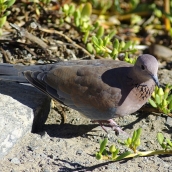Senegal Dove (Streptopelia senegalensis)
Dove measuring 23-26 cm in total length, with a wingspan of 40-45 cm. The back is golden-brown, wing edges are greyish-blue, the belly is paler and a black-tipped orange collar encircles the neck. The distinctive sound of this bird is different from that of other doves. It is present throughout the Canaries but specifically in Lanzarote, Fuerteventura, Gran Canaria, Tenerife and La Gomera, though nesting has not been confirmed in Tenerife. There has also been a recent sighting in La Palma. Colonization has occurred from east to west, the most likely origin being in Northwest Africa, where it is at the height of expansion. Initially, the origin of birds observed in the Canaries was questioned because this species is often kept in captivity. It lives in clumps of tamarisk (Tamarix spp.), rural and urban gardens, orchards and leafy tourist areas of palms and other species, and often coexists with the collared dove (Streptopelia decaocto). It feeds mainly on grain and food remains on the ground, as do other doves. It breeds in several kinds of trees, both wild and ornamental, although there is very little information about its nesting habits in the Canaries. A clutch of 2 eggs is laid and the breeding season extends from February to May. The confirmed expansion in the Canaries in recent years points to the gradual colonization of the entire archipelago, not unlike that of the collared dove. Populations are constantly growing and it is difficult to estimate annual numbers in the islands. However, 20-30 pairs have been calculated for Fuerteventura. This species provides one of the best examples of recent bird colonization in oceanic islands and neighbouring continental regions.













